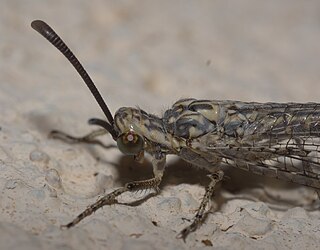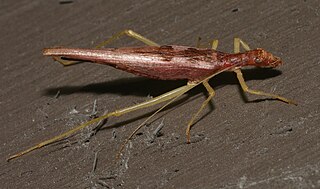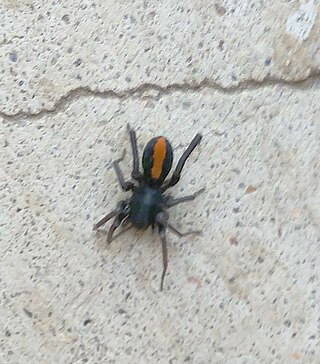
Lynx spider (Oxyopidae) is a family of araneomorph spiders first described by Tamerlan Thorell in 1870. Most species make little use of webs, instead spending their lives as hunting spiders on plants. Many species frequent flowers in particular, ambushing pollinators, much as crab spiders do. They tend to tolerate members of their own species more than most spiders do, and at least one species has been identified as exhibiting social behaviour.

Peucetia is a genus of lynx spiders that is found worldwide.

Peucetia viridans, the green lynx spider, is a bright-green lynx spider usually found on green plants. It is the largest North American species in the family Oxyopidae. This spider is common in the southern U.S., Mexico, Central America, and in many West Indies islands, especially Jamaica. Lynx spiders are hunters specialized for living on plants. This species does not use a web to capture its prey. It pounces on its prey in a cat-like manner, which is the reason for the name lynx. It is active during the day.
Enoplognatha marmorata, the marbled cobweb spider, is a species of cobweb spider in the family Theridiidae. It is found in North America.

Scotoleon is a genus of antlions in the family Myrmeleontidae. There are more than 20 described species in Scotoleon.

Neoxabea is a genus of smooth-legged tree crickets in the family Gryllidae. There are about 14 described species in Neoxabea.
Cyclotelus is a genus of stiletto flies in the family Therevidae. There are more than 20 described species in Cyclotelus.
Arctosa sanctaerosae, the Santa Rosa wolf spider, is a species of wolf spider in the family Lycosidae. It is found in the United States.
Clubiona riparia, the riparian sac spider, is a species of sac spider in the family Clubionidae. It is found in Russia, Mongolia, China, Japan, and North America.

Scotoleon longipalpis is a species of antlion in the family Myrmeleontidae. It is found in Central America and North America.
Socalchemmis idyllwild is a species of false wolf spiders & wandering spiders in the family Zoropsidae. It is found in the United States.
Porrhomma convexum is a species of sheetweb spider in the family Linyphiidae. It is found in Canada, Europe, Caucasus, and Russia (European).
Tibellus duttoni is a species of running crab spider in the family Philodromidae. It is found in the United States and Mexico.

Castianeira crocata is a species of true spider in the family Corinnidae, sometimes called by the common name red stripe spider. The species was first described by Nicholas Marcellus Hentz in 1847. It is found in the United States. Though its body shape is quite different, its characteristic black body and red-marked back puts it at risk of being mistaken for a black widow spider.

Chrysobothris femorata, the flatheaded appletree borer, is a species of metallic wood-boring beetle in the family Buprestidae. It is found in Central America and North America.

Narnia wilsoni is a species of leaf-footed bug in the family Coreidae. It is found in North America.

Narnia is a genus of leaf-footed bugs in the family Coreidae. There are six described species in Narnia.

Narnia snowi is a species of leaf-footed bug in the family Coreidae. It is found in North America.

Narnia femorata is a species of leaf-footed bug in the family Coreidae. It is found in Central America and North America. It feeds on cacti, including Opuntia phaeacantha, Ferocactus wislizeni, and Saguaro, as well as Cirsium thistle.
Cylindrarctus is a genus of ant-loving beetles in the family Staphylinidae. There are about 10 described species in Cylindrarctus.











